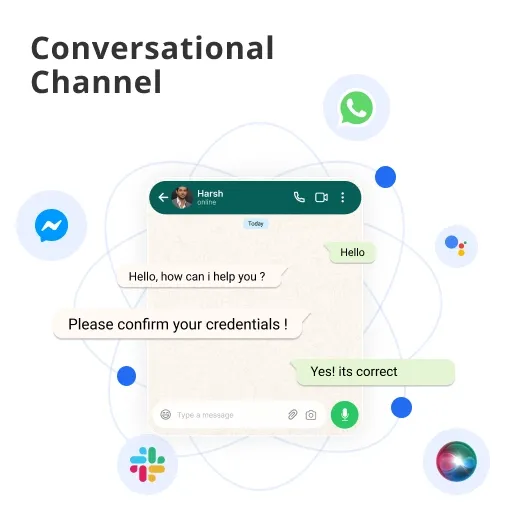What is a Conversational Channel?
A Conversational Channel is a communication platform where users can interact with chatbots or virtual assistants through natural language conversations, such as messaging apps, social media, websites, or voice assistants.
Conversational channels are the lifeblood of customer engagement. They help businesses understand customer needs, provide support, and even boost sales. It's like having a friendly neighborhood storekeeper who knows your name and your favorite snack!
Why use Conversational Channels?
1. Enhancing Customer Experience
Ever sent a smoke signal to a business, only to be met with dead silence? Conversational channels ensure customers get the attention they deserve. By providing prompt, personalized service, businesses create memorable experiences that keep customers coming back for more.
2. Streamlining Support and Sales
Time is money, and conversational channels save heaps of both! With quick, efficient communication, businesses can resolve customer issues and close deals faster than you can say "cha-ching!"
3. Building Brand Loyalty and Trust
Nothing says "I care" like a heartfelt conversation. By engaging with customers through conversational channels, businesses build trust and loyalty that lasts longer than the latest TikTok dance craze.
Types of Conversational Channels
1. Messaging Apps

A. Facebook Messenger
With billions of active users, Facebook Messenger is a one-stop shop for engaging with customers, providing support, and even processing orders.
B. WhatsApp Business
A favorite among small businesses, WhatsApp Business allows companies to create catalogs, send updates, and provide customer service in a familiar environment.
C. WeChat
China's "app for everything," WeChat is the perfect platform for businesses targeting Chinese markets, offering services like booking appointments, making payments, and customer support.
2. Voice Assistants

A. Amazon Alexa
Alexa, Amazon's voice assistant, can be integrated with custom skills to provide users with information, control smart devices, and even make purchases.
B. Google Assistant
Google Assistant, available on Android devices and Google Home, is a powerful voice-activated assistant that can answer questions, control devices, and interact with other services.
3. Website Chat Widgets
You know those friendly little chat bubbles that pop up on websites? Say hello to website chat widgets!
A. Live Chat
Live Chat widgets are a fantastic way to provide real-time support and engage with users while they're browsing your website.
B. AI-Powered Chatbots
These smart little helpers can handle customer inquiries 24/7, providing instant support and information, even when you're catching some Z's.
4. Social Media Platforms

Let's not forget the ever-popular social media, where businesses can have meaningful conversations with their audience.
A. Twitter
Tweet, tweet! Twitter is an excellent platform for sharing updates, answering customer questions, and even handling support issues in 280 characters or less.
B. Instagram
Picture this: engaging with customers through Instagram's Direct Messaging feature, providing support, and sharing eye-catching content.
5. Email and SMS
Oldies but goodies, email and SMS still have a place in the conversational channel mix.
A. Email Conversations
Emails provide a more personal touch, allowing businesses to send newsletters, and promotional offers, and engage in one-on-one conversations with customers.
B. SMS Messaging
Short, sweet, and to the point! SMS messaging is perfect for sending appointment reminders, order updates, and quick support messages.
Who can Benefit from Conversational Channels?
1. Businesses and Organizations
From mom-and-pop shops to multinational corporations, businesses of all shapes and sizes can benefit from conversational channels. It's like having a magic wand that makes customers feel heard, understood, and valued.
2. Customer Support Teams
Conversational channels are like an energy drink for customer support teams. With faster response times and streamlined communication, these channels help support agents tackle customer issues like superheroes!
3. Sales and Marketing Professionals
Who says sales and marketing can't be fun? Conversational channels let professionals charm their way into customers' hearts (and wallets) with engaging, personalized interactions.
When to Implement Conversational Channels
1. Stages of Business Growth
Whether you're a fledgling startup or an established enterprise, there's never a wrong time to implement conversational channels. Like adding sprinkles to your ice cream, these channels are the cherry on top of a thriving business.
2. Identifying Customer Needs
Businesses must first understand their customers' needs to implement conversational channels effectively. Businesses can tailor their channels to provide the ultimate customer experience by analyzing customer feedback, behavior, and preferences.
How to Choose the Right Conversational Channel for your Business
1. Assessing Your Audience
Choosing the right channel is like picking the perfect pair of shoes—it's all about knowing your audience. Consider factors like demographics, preferences, and online habits to determine which channel will have your customers clicking their heels in delight.
2. Evaluating Channel Features
Not all conversational channels are created equal! Evaluate the features of each channel (like response times, integration options, and customization) to find the best fit for your business. It's like choosing between a Swiss Army knife and a butterknife!
3. Integration and Compatibility
The best conversational channels play well with others. Ensure your chosen channel integrates seamlessly with your existing systems and tools, ensuring a smooth, hiccup-free customer experience.
Best Practices for Conversational Channels
1. Ensuring Fast Response Times
Don't keep customers waiting! Fast response times are the secret sauce for successful conversational channels. Set goals, monitor performance, and fine-tune your strategy to keep customers happier than a clam at high tide.
2. Providing Personalized Experiences
Customers love to feel special, and conversational channels are your ticket to creating personalized experiences. Use customer data and preferences to tailor your interactions, making each conversation feel like a one-of-a-kind masterpiece.
3. Maintaining Data Privacy and Security
With great conversational power comes great responsibility. Keep customer data safe by implementing robust privacy and security measures. After all, nobody likes a conversational channel with a leaky faucet!
Measuring the Success of Conversational Channels
1. Key Performance Indicators (KPIs)
What's a conversational channel's report card? Key Performance Indicators (KPIs)! Monitor metrics like response time, customer satisfaction, and conversion rates to ensure your channels are hitting the mark and making the grade.
2. Analyzing Customer Feedback
Listen to the people! Customer feedback is a treasure trove of insights that can help you fine-tune your conversational channels. Keep your ears to the ground and your channels primed for success.
Omnichannel Communication Strategies
In the future, businesses won't be content with just one or two conversational channels. They'll embrace omnichannel communication strategies that provide a seamless, consistent experience across multiple platforms. Here's what to expect:
1. Unified Customer Profiles
Businesses will create unified customer profiles, allowing them to access customer data and preferences across all channels. It's like having a cheat sheet for every customer interaction!
2. Channel Hopping
Customers can hop between channels without losing the context of their conversation. Start a chat on Facebook Messenger, continue on live chat, and finish via email—it'll be a conversational parkour!
3. Data-Driven Channel Selection
Businesses will use data and analytics to determine the most effective channels for different customer segments, ensuring they're always meeting customers where they're most comfortable.
4. Consistent Brand Voice
Regardless of the channel, businesses will maintain a consistent brand voice and style, creating a cohesive, recognizable experience that customers will come to know and love.
FAQs
1. What are examples of Conversational Channels?
Examples of Conversational Channels include messaging apps (WhatsApp, Facebook Messenger), voice assistants (Amazon Alexa, Google Assistant), and website chat widgets.
2. Why are Conversational Channels important?
Conversational Channels enable businesses to engage with customers through natural language interactions, providing better support, sales opportunities, and personalized experiences.
3. How do Conversational Channels improve user experience?
Conversational Channels allow users to interact with businesses in a familiar, user-friendly way, leading to quicker resolutions, increased satisfaction, and stronger customer relationships.
4. Can Conversational Channels handle multiple languages?
Yes, many Conversational Channels can be configured to support multiple languages, allowing businesses to cater to a diverse customer base and expand globally.
5. How do I integrate a Conversational Channel into my business?
Choose a suitable platform, design a chatbot or virtual assistant, and ensure it aligns with your business goals. Then, implement the chatbot across your selected channels for seamless customer interactions.

